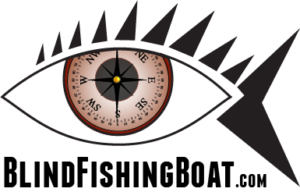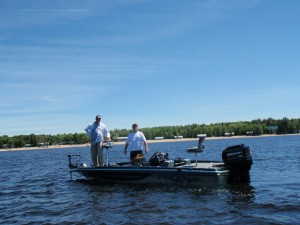Blind Anglers International Tournament
Each year when this Pike / Walleye tournament for fishers with vision loss comes up, it’s always a question about which technology I should show-case. Well, this year mother nature narrowed the options by lowering the water levels to the point that launching my 20-foot power cat was a non-starter. Fortunately, my sighted pilot and good fishing buddy, Doug Catton, keeps his bass boat on the river so was able to take aboard our non-sighted guest fisher for the day, Dave Furgoch, and shadow me as I fished from the original Blind Fishing Boat (12-foot Porta-Bote). Each of the other non-sighted fishers are matched with sighted volunteers who provide a seat or two in their boat for the day.
Photo of Doug Catton and Dave Furgoch aboard Doug’s 21-foot Pro Craft bass boat
The night prior to the event there was the traditional red-carpet dinner, and what a feast! I was asked to say a few words on behalf of the non-sighted fishers participating in the event, and to give the key-note address.
Photo of Lawrence at the podium
Prior to the days fishing getting underway, the organizers spoke about a more relaxed start time, which is my excuse for what happened on the water just off the docks. Doug and I informed the organizers we would leave last, so as each team left the dock I assumed they were heading out to start fishing. Doug then gave me what I thought was the signal to follow him, so I took off and headed for the sound of his engine thinking that we were leaving. I surprised us both when I t-boned his fiberglass bass boat with my plastic Porta-Bote. Turns out the actual start was still to come as the other boats had simply moved off shore and were waiting for the “trickle start to begin. In hind sight, I probably should have installed the forward-looking sonar before we started.
Photo of Lawrence piloting his 12-foot Blind Fishing Porta-Bote
We ran for half an hour out across the large bay to fish the mouth. There was a good head wind that kicked up some white caps, but nothing my boat couldn’t handle. Once we arrived at our spot, maintaining boat position was a challenge due to the wind. I fished from the back of the boat and kept the motor in reverse running at a low speed, which kept me from being blown out into the deeper water. The wind in my face and the sound of the trees on shore were ample indicators for me to navigate up and down the shore line. I always new when I was getting into weeds by the sound of the prop on the Minn Kota would begin to make.
Photo of Lawrence fishing from the back of the Blind Fishing Boat
We fished nine hours before letting the wind blow us the mile distance back to the start. We caught quite a number of Pike, mainly on Rapala Husky Jerks, but this year’s warmer spring weather meant the fish had finished spawning some time back and many of the larger breeders had already left for the deeper main channel of the river. The few boats that went out into the main part of the river did better, with the largest pike being caught that day weighing in at just over 9lbs.
It felt good to be out on such a big body of water fishing alone in my own boat. The wind, waves and birds in the trees along shore assisted with navigation, which meant I was able to head off and fish where I pleased without having to depend on Doug for suggestions on boat placement. There were quite a number of times when I could have sworn I was all alone.
Fishing big water in the Blind Fishing Boat is quite a bit different than the smaller lakes and bays I generally fish, in that there is far fewer man-made sounds. The electric Minn Kota motor runs almost silently and the waves slapping the hull of my plastic Porta-Bote are muffled making for a real sensory experience in that there are no harsh or unnatural sounds that reduce ones sensory range.
A big hat’s off to the organizers of the 22nd annual BAIT event and to all those who made up the 22 teams that took part.




